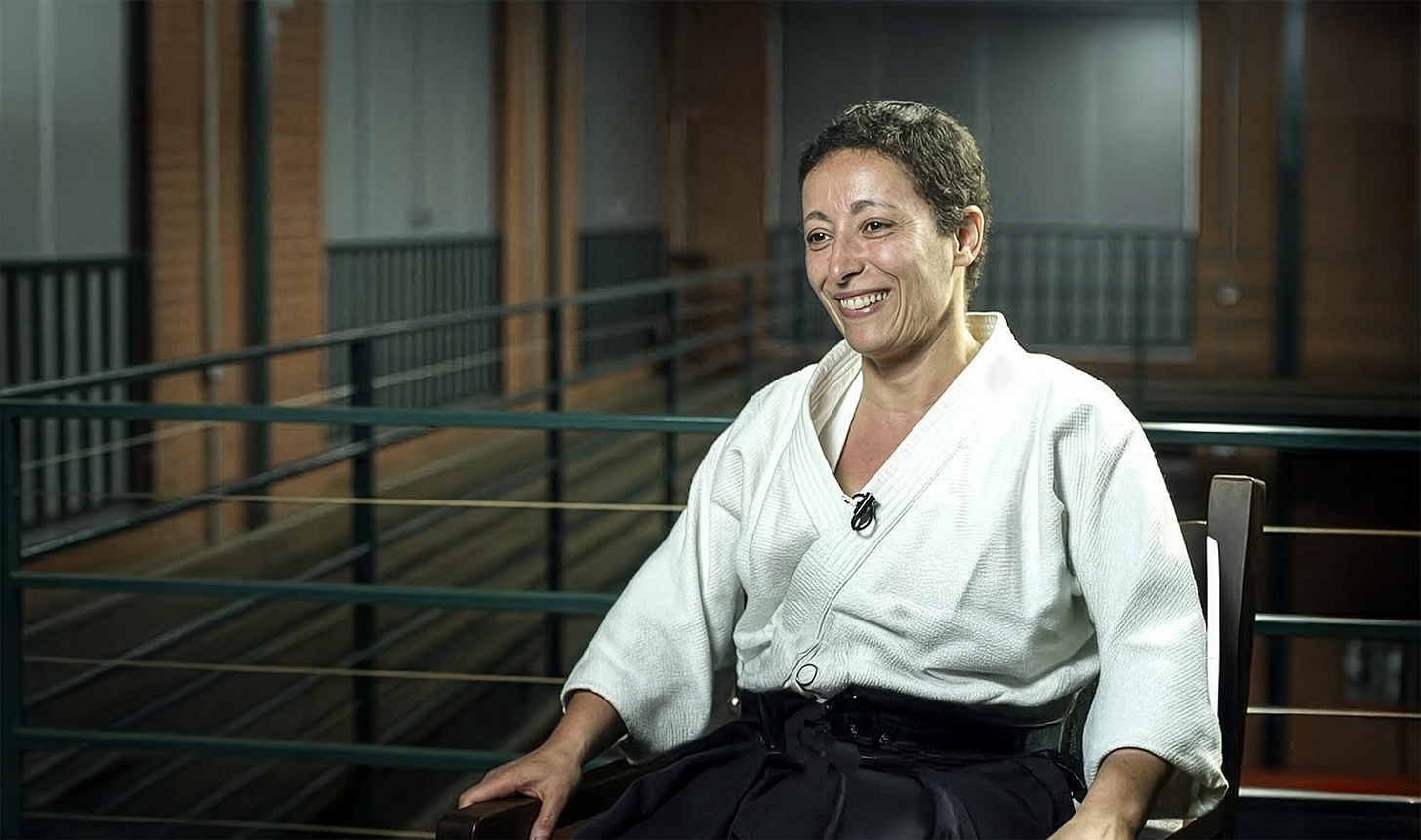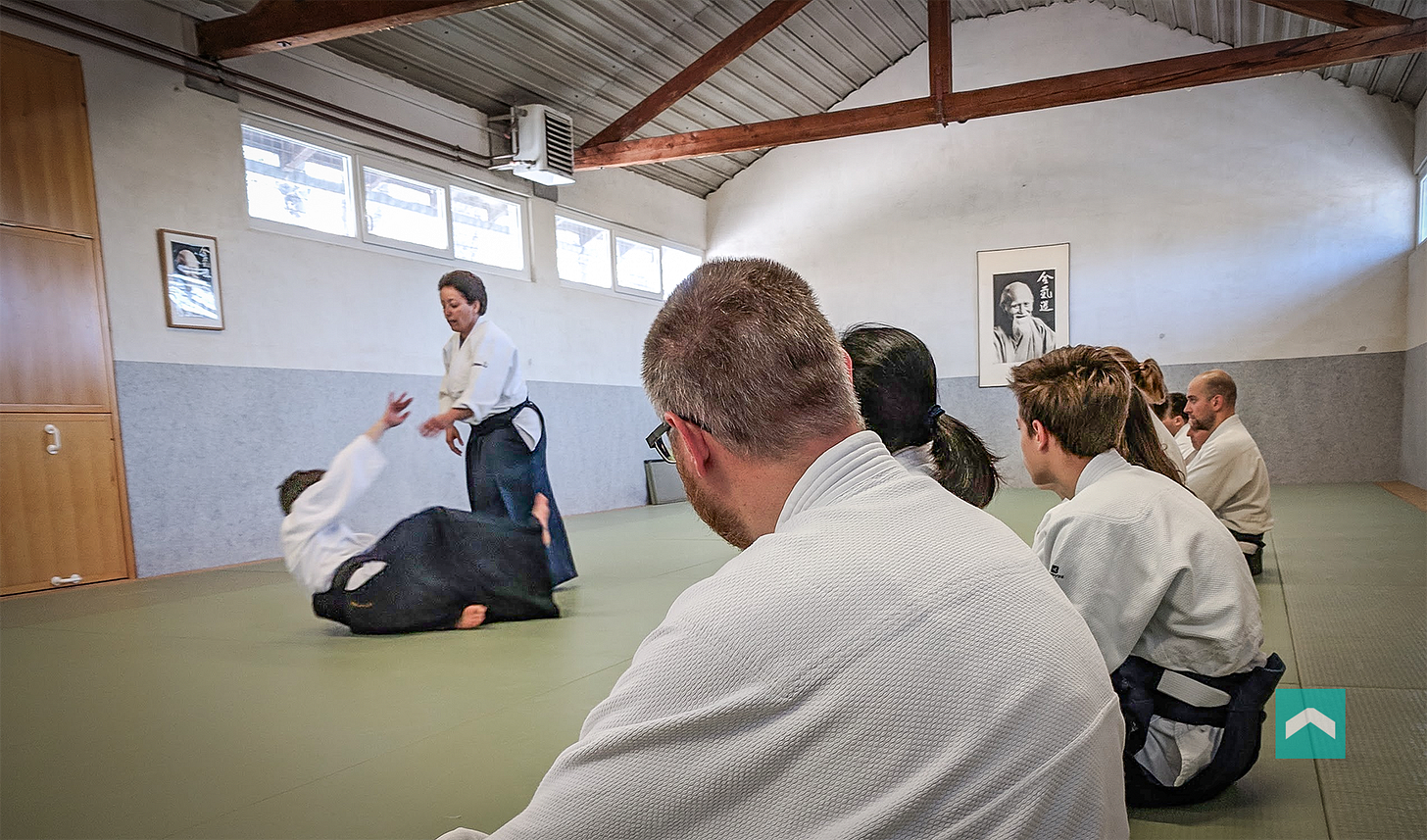The teacher who put students first
European Aikido Voices: Nadia Korichi on choosing integrity over institutions
In our European Aikido Voices series, we highlight journeys of those who make Aikido about human connection, care and mutual respect, before technique, politics, or prestige. Today, we’re honored to feature Nadia Korichi, a master instructor whose 25-year journey reveals what happens when you consistently choose students over systems.
The foundation of everything
“I am, at heart, a person shaped by simplicity. I was raised in a modest family, in an unpretentious place, and I carry that grounding within me as a quiet compass.”
This isn’t false modesty from someone who built one of Europe’s most successful youth aikido programs. It’s the bedrock philosophy that guided Nadia Korichi through decades of international teaching, institutional pressures, and ultimately, a choice that would redefine her entire relationship with the art.
For 25 years, Nadia traveled across Europe and beyond, teaching seminars and building connections across cultures. But her proudest achievement wasn’t the prestigious invitations or international recognition. It was over 160 teenagers who genuinely loved training in her dojo.
“You have to take care of them. You have to really want to work with them, not only just to show yourself,” she explains.
While other programs struggled to retain young students, her approach created something different—a community where teenagers actually wanted to spend their time.
When values meet reality
The success came from living three core principles that eventually put her at odds with institutional expectations.
Authenticity over politics became her first cornerstone. “I want people to be honest,” she says simply. This meant teaching what genuinely made a difference with students rather than what looked impressive at seminars. It meant acknowledging when traditional approaches needed adaptation for contemporary learners. Most challenging of all, it meant speaking truthfully about organizational problems including inequality and commercialization that she observed in the broader aikido world.
Service, not self-promotion, guided her teaching philosophy. “I never sought recognition through popularity,” she reflects. Even as her reputation spread internationally, her focus remained on nurturing students rather than advancing herself. The 160 teenagers thrived because their teacher genuinely invested in their growth, not because she needed validation of her own status.
Universal inclusion shaped every choice she made as a teacher. “I wanted a universal Aikido, one that truly connects people across cultures.” This was not abstract language but a guiding principle in her daily teaching. It meant adapting communication styles, recognizing different learning preferences, and creating space where every student could find their own way into the art.
The Moment of Choice
Five years ago, these values collided with institutional realities. The very qualities that made her program thrive—cultural sensitivity, student-centered focus, and honest recognition of systemic problems—soon created friction with organizational expectations.
“I began making it clear to everyone that I could not agree,” she recalls. “I told them, you say you want young people to come, yet you keep presenting models that do not reach them. If the aim is truly to engage youth, then we must show them something that speaks to their reality.”
Her criticism was precise: leaders spoke of youth engagement while showcasing only aging authority figures. They invoked inclusion while closing doors to diverse voices. Success was measured through hierarchy and politics rather than genuine student development.
When she continued to speak plainly about these contradictions, the response was swift: she was pushed aside. The very integrity that had sustained her teaching became a threat to systems more concerned with preservation than renewal.
Her concerns reached beyond gender.
“For me, it’s not normal that someone receives grades simply for loyalty or technical display, without proving themselves as genuine teachers.”
The deeper wound lay in how ordinary practitioners were regarded:
“There is scarcely any regard for the practitioners themselves. Too often, those in professional positions reduce them to financial instruments—treating dedicated students as revenue streams rather than human beings in search of growth.”
The Cost of Authenticity
The consequences were immediate. Professional relationships changed. Income disappeared. The institutional support system she’d been part of for decades closed ranks against her voice.
Through this difficult period—compounded by the loss of both parents—a deeper understanding emerged. The real secret wasn’t in the techniques or the ranks or the organizational politics.
“Aikido lives in the care you show to people. If everyday practitioners are not respected, the art loses its heart.”
This insight explains the success with 160 teenagers. They thrived not because of superior technical instruction, but because someone genuinely cared about their development as individuals. They stayed because they felt seen, respected, and valued—not just as students, but as people.
Looking Forward
Today, Nadia stands as a guide for what European aikido could yet become: a practice shaped by care for practitioners, genuine respect, and a vision of networks that rise above institutional limits.
Her forward focus is clear: creating an international women’s network that enhances practitioner development, amplifies women’s contributions, and builds authentic connections across cultures while drawing on her experience with traditional organizational approaches to create something more effective.
“I just want to help where I can. My wish is to see Aikido practiced with calm honesty and genuine respect.”
Her story reminds us why we train—not for rank or recognition, but for the transformation that happens when authentic teaching meets genuine learning. When someone with deep skill and deeper character decides that students matter more than systems.
Her dojo became proof that Aikido flourishes when taught with care and integrity. In our next post we will share how to build such student-centered practice in your own dojo. → Subscribe to receive it first.
“The heart of Aikido is the care you give to people—the art only truly lives when we honor those who step on the mat beside us.”
That line is as true for a single class as it is for the future of the art.
In future posts, we’ll explore the practical approaches that created such remarkable engagement with young practitioners—because the world needs more teachers who understand that care, not curriculum, creates lasting transformation.





Couldn't agree more. This piece beautifully highlights why consistently choosing students over systems is the only way forward. As a math and CS teacher, it truly makes me wonder how we can foster this profound human-centered approach within our eduction systems, even with all the new AI tools. Inspiring!